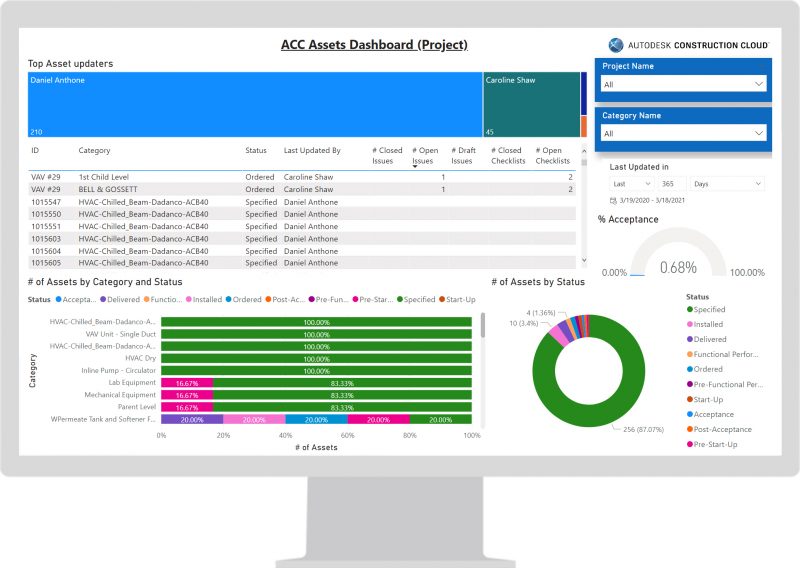Construction teams are capturing more data than ever before. With the amount of activity happening daily on a jobsite, it’s easy to see how data can build up and become overwhelming to understand. According to FMI, 95% of the data generated by construction and engineering firms goes unused, which means we only have room to improve.
Teams don’t necessarily need more data; they need more insights that will help them leverage data more effectively in decision making. So, where do we start?
The first step is ensuring you have access to all of your project data and the right analytics tools to visualize further. The Autodesk Construction Cloud platform and BIM 360 has a great set of prediction and analytics capabilities built directly into the product. However, we know that many construction teams still rely on additional business intelligence tools, like Power BI or Tableau, in tandem with our technology to evaluate their company’s performance.
With Data Connector, teams can now quickly extract project data from the Autodesk Construction Cloud platform or BIM 360 for customized use in business intelligence tools, all through a single click. This saves teams time and money by giving them a built-in tool to extract data without needing expensive APIs or custom code. It also gives them the ability to improve data visualizations to make more informed business decisions.
Curious to see how Data Connector is being used by construction teams today? Let’s explore how Barton Malow has been utilizing Data Connector in their business operations.
Strengthening Technology Adoption
Ted Jennings, a Senior VDC Manager at Barton Malow, started using the data exported from the BIM 360 Data Connector to understand at an account level how various projects teams were onboarding as well as to look at the specific action’s users were taking within BIM 360. By understanding these trends, Jennings and his team were able to cultivate best practices and improve overall adoption of BIM 360 across all of their project teams.
“One big win we came away with after looking into our usage data was that we noticed a lot of people were wrongly assigning subcontractors roles,” said Jennings. “We realized that the existing role tagged as ‘Field Team’ was getting overlooked so by changing it to ‘Subcontractor’ teams began to more appropriately assign this role. This is one example of how a simple categorization mistake can lead to people not being given the right permission levels or access to the documents they really need.”

Understanding Project and Company Wide Performance
Evaluating project level performance has always been a critical part of any construction project, especially when it comes to looking at daily reports or analytics. However, cross project analysis is also an essential part of ensuring companies are getting a holistic view of how they are performing at an executive level. If you consider the amount of data generated from just a single project, you understand that looking at the data across tens of other projects is exponentially challenging to evaluate and compare.
Additionally, many teams are also using multiple software solutions, like ERP systems, financial applications, and other project management tools. So having the ability to aggregate all of their data into a single view is essential. This is a key reason many construction firms are turning to business intelligence tools that are made specifically to help visualize and compare larger amounts of data to help them understand what areas of their business need attention.
“It is critical for us to see a deeper level of cross project analytics and the Data Connector allows us to better understand project trends and commonalities so we can make decisions around how to mitigate those issues.” – Ted Jennings, Senior VDC Manager, Barton Malow
This was a key outcome Jennings wanted to achieve, as it was important for Barton Malow to use their business intelligence tools to evaluate their company performance across all of their projects. “It is critical for us to see a deeper level of cross project analytics and the Data Connector allows us to better understand project trends and commonalities so we can make decisions around how to mitigate those issues,” said Jennings.
Improving Project Quality
Although the Barton Malow team started leveraging Data Connector to help improve their onboarding and adoption, they are now focusing on diving even deeper into analyzing cross workflow trends to improve their project delivery. By evaluating things like RFIs, Submittals, and Issues across projects, Jennings and his team can now have a clear understanding of what actions need prioritizing and improve overall project success.
The other great thing about using the Data Connector is that any unique dashboard created within Power BI or Domo can also be viewed back within the Insight or Project Home modules in Autodesk Construction Cloud platform and BIM 360. This means that teams can leverage the powerful and customizable analytics features in business intelligence tools, but still have a centralized place to view all of their data.

Get Started with Data Connector Today
As more construction firms start adopting tools like the BIM 360 Data Connector to help leverage their data, teams will begin to see improvements in the way they do business. Whether that is better adoption of technology, streamlining project controls, or improving overall project quality, using data allows teams to learn and grow their business into the future.
Need help getting started with Data Connector?
Download our free Power BI template.
The post How to Connect Your Project Data with Business Intelligence appeared first on Digital Builder.
Did you miss our previous article…
https://www.clarkeconstructioncreations.com/?p=1203
